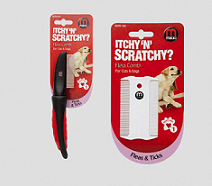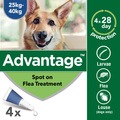The battle with fleas is ongoing if you own a dog or cat. When you think the problem’s treated, your pet is suddenly scratching again, you’re waking up with bites, and there’s black specks all over the furniture.
Unfortunately, fleas don’t take a holiday and need to be treated against on a regular basis. This goes for your home as well, as roughly 95% of flea eggs, larvae and pupae exist in the environment, rather than on your pet.
What should I do if I notice fleas?
- If your pet is scratching more than usual, you’re getting bitten, or you’re noticing black flecks (flea faeces) on your bedding, furniture and carpets, then the chances are your pet has fleas.
- Use your fingers or a flea comb to part your pet’s coat and see if you can spot any. If they’re not immediately obvious, wipe your hand over the floor or your pet’s bedding to look for specks. If you’re still not sure, contact your vet for a professional opinion.

- It is important that you treat your pet and your house at the same time. If you don’t, re-infestation is highly likely.
- The first step is vacuuming. As 95% of the household flea population lives in the environment, it is important to concentrate your efforts here. Vacuuming the house thoroughly kills flea eggs, flea larvae and flea pupae. Pupae are impervious to topical insecticides which is why vacuuming is essential. Don’t forget to vacuum crevices in floorboards, along skirting boards and underneath furniture and rugs.
- Machine wash all bedding and fabrics at a high temperature. This goes for blankets, rugs, towels, cushion covers etc. There’s no need to use an insecticide as well. Do this regularly, whether you suspect fleas or not.
- For all remaining areas, use a household flea spray such as Indorex. Indorex has a higher Permethrin content than other household flea sprays, meaning your home is protected for longer. It also contains Piriproxyfen to prevent flea and dust mites hatching for 12 months. One can contains enough to treat a 3-bed semi-detached house!
- Treat your pet with a spot-on or flea tablet to eradicate the population on your pet. Frontline, Advantage and Effipro are popular products designed to break the flea life-cycle and destroy the next generation of fleas. It is important that you only use a treatment that is recommended for your pet specifically e.g. don’t use a dog treatment on a cat or vice versa, and dose according to your pet’s weight. Some flea treatments can only be purchased with a prescription from your vet.
How often should I treat my pet and house? 
- Aim to ‘treat’ your house regularly by vacuuming often and washing your bedding and fabrics every week or so. This will help keep on top of and break the flea life-cycle.
- You should aim to treat your pet monthly as the flea life-cycle is typically around 21 days. Some oral treatments can be given as and when fleas are noticed, but the spot-ons are generally effective for a month.
- People tend to think of indoor cats as being immune to fleas, but unfortunately this isn’t the case. Fleas can be carried in on people’s clothing and other pets, so it is important to maintain a flea programme regardless. Outdoor cats and dogs may need more attention paying as they are likely to keep re-infecting themselves.
If you've found this article helpful, you may be interested to read our other related blogs: Why should I worm and flea my pet regularly?, Spring clean your home from fleas, What you need to know about fleas, Cat fleas, Top 5 myths about fleas, Help! My pet's got fleas.
If you need any advice on choosing a suitable product, please don’t hesitate to get in touch by emailing [email protected] or commenting below.
Written by: Hannah








